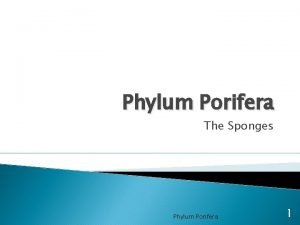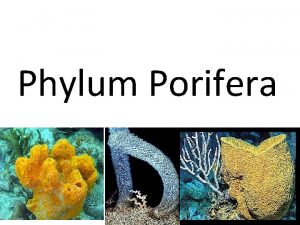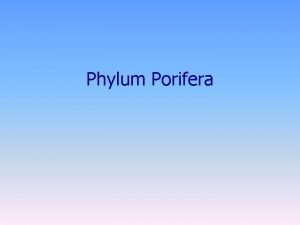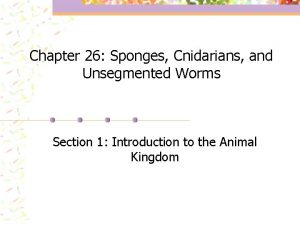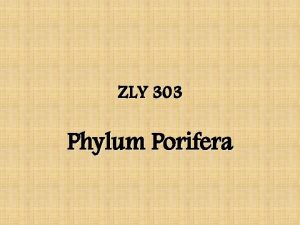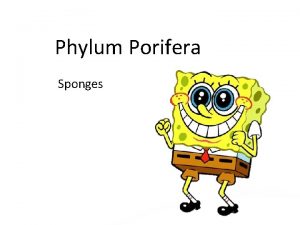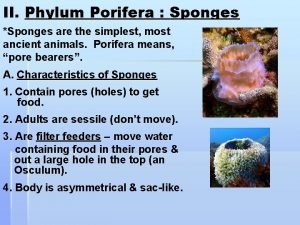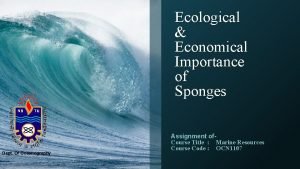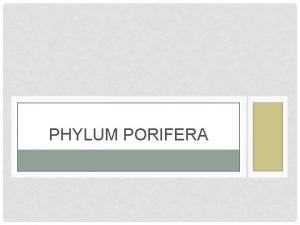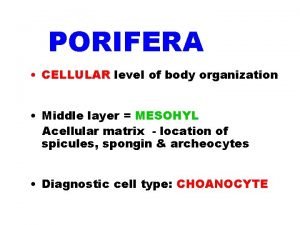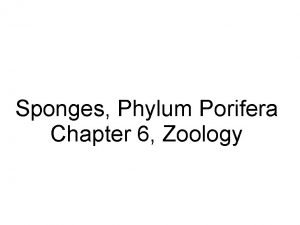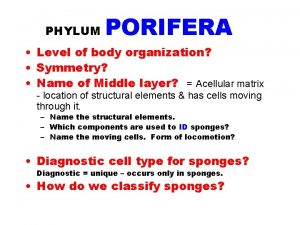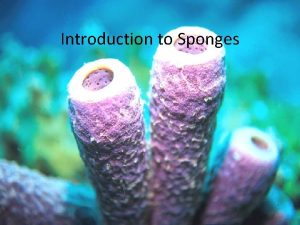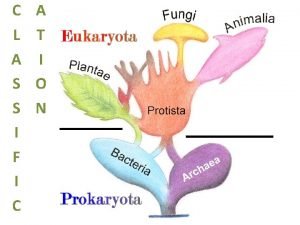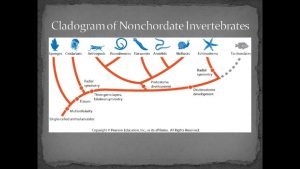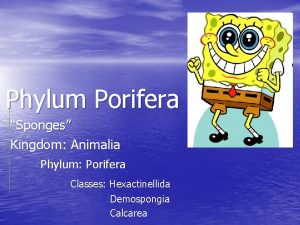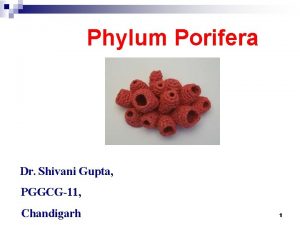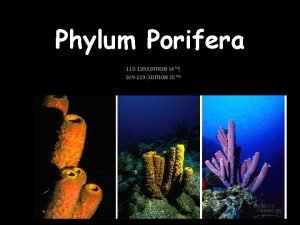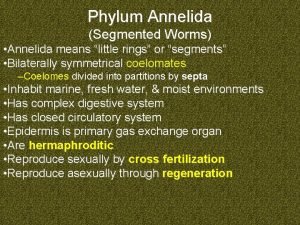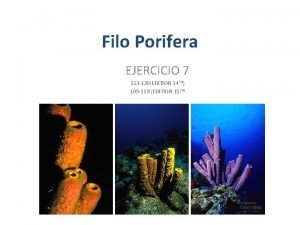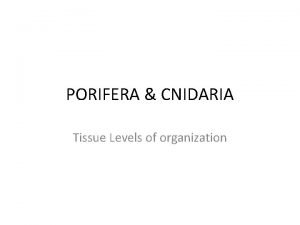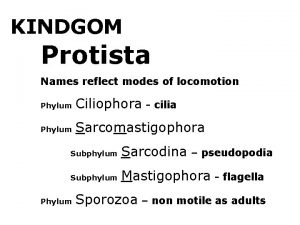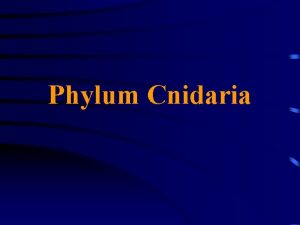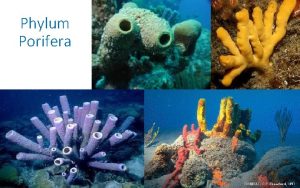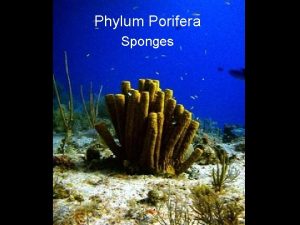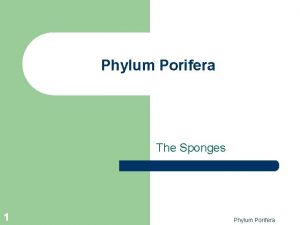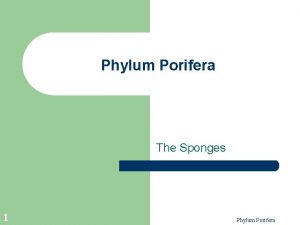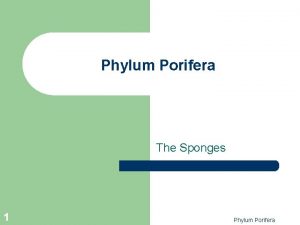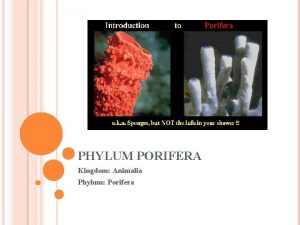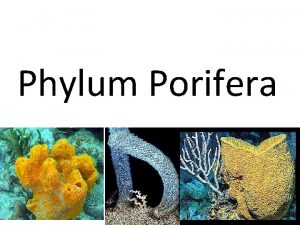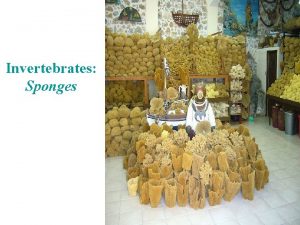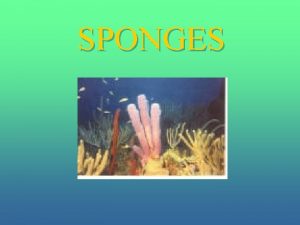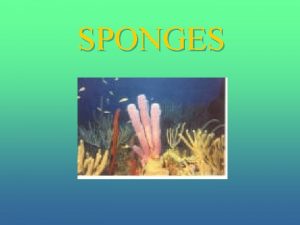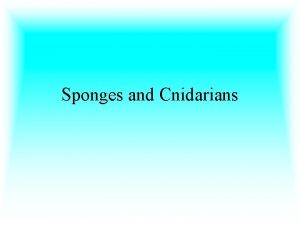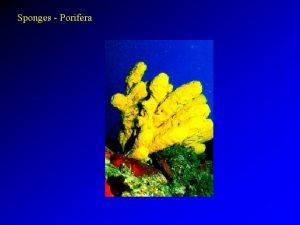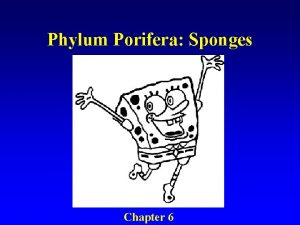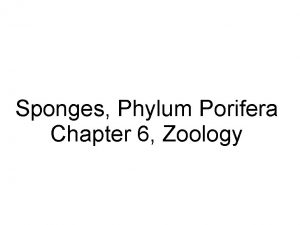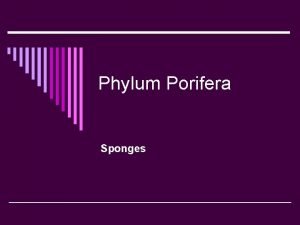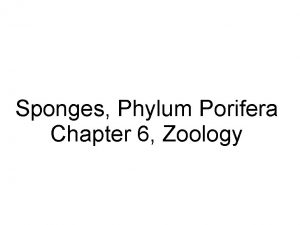Phylum Porifera General Characteristics SPONGES Simplest of all
























- Slides: 24

Phylum Porifera

General Characteristics �SPONGES! �Simplest of all animals �Cellular level organization �Specialized cells, but no tissues (bodies are a loose aggregation of cells) �No true tissues or organs �Radial or asymmetrical �Marine and Freshwater �Saltwater are colorful �Freshwater are dull green color

General Characteristics Cont. • Sponges are sessile (not free moving) as adults • Free swimming larval stage called dipleurula • Porifera means pore-bearing • Water enters through pores (ostia) bringing in food and oxygen • Sexual & Asexual Reproduction • Osculum- large opening at the top where excess water leaves

WATER OUT Water Flow Through the Sponge WATER IN Osculum

3 Basic Cell Types 1. Pinacocytes 2. Mesenchyme Cells 3. Choanocytes

3 Basic Cell Types • 1. Pinacocytes- flat cells that line the outer surface of the sponge. –May be slightly contractile –Porocyte: a specialized type of pinacocyte; are tube-like in shape; contractile; and can regulate water circulation.

� 2. Mesenchyme Cells- move around in the mesohyl layer; are specialized for reproduction, secreting the skeleton, transporting/storing food. �Amoebocyte: jelly-like layer just underneath the pinacocyte layer. (makes spicules – skeletal)

• 3. Choanocytes- flagellated cells that line the inner chamber of the sponge; called collar cells. –Flagellum: flagella spins to create water currents to pull in water and food –Collar: “trap” plankton and other fine particles from the water

Choanocyte

Structural Skeleton �Consists of either one or all of the following: �Spicule: microscopic needle-like spikes that are made of Calcium carbonate (Ca. CO 3) or silica (glass). �Spongin: a fibrous protein made of collagen

Sponge Skeletons Silica Spicules Limestone Spicules SPONGIN

Sponge Body Types • 3 Kinds–Ascon – Sycon –Leucon

Ascon • Simple tube perforated by pores • Open internal part of tube is called the spongocoel (coel = gut) • Are vase-like • Least common type of sponge • Single opening to the outside called the osculum

Sycon • Sponge wall is folded into canals • Choanocytes line the radial canals to move water osculum

Leucon • Have an extensively branched canal system. • Multiple canals lined with flagellated cells • Multiple ostia for water to exit • Increased surface area means more water can move through sponge

Body Forms Summary

Reproduction �Sexual Reproduction- sponges are monoecious (male and female in the same body) �Release sperm and eggs into the water from the Osculum �Cross-Fertilization takes place in the ocean Fertilized eggs form larvae which swim off looking for a place to settle

Reproduction Sponge Releasing Eggs & Sperm

Reproduction Cont’ o Sponges can regenerate (regrow) lost body parts through mitotic cell division (asexual) o Sponges also reproduce asexually by (budding)

Reproduction Cont’d gemmule �Asexual Reproduction- involves the formation of gemmules �gemmules: resistant capsules that sponges release to survive unfavorable conditions. When conditions become favorable, the gemmules sprout into sponges.

CLASSES • Phylum Porifera – 3 Classes • Class Calcarea • Class Hexactinellida • Class Demospongiae

Class Calcarea • • Spicules made of Calcium Carbonate Can have all three body forms Most primative Ex. Grantia

Class Hexactinellida • Deep sea sponges • Can have syncon or leucon body forms –Often fused into an intricate lattice –Glass sponges (silica)

Class Demospongiae • • Spicules made of silica, spongin, or both. Most common (fresh (green) & salt) All are Leuconoid Ex: bath sponge
 Struktur porifera
Struktur porifera Ascon
Ascon Sponges characteristics
Sponges characteristics Sponges belong to the phylum
Sponges belong to the phylum Morski sundjer
Morski sundjer Examples of sponges invertebrates
Examples of sponges invertebrates Phylum porifera body plan
Phylum porifera body plan Phylum porifera description
Phylum porifera description Importance of sponges
Importance of sponges Phylum porifera questions
Phylum porifera questions Phylum porifera level of organization
Phylum porifera level of organization Leucosolenia
Leucosolenia Phylum porifera symmetry
Phylum porifera symmetry Phylum porifera is classified based on
Phylum porifera is classified based on Features of porifera
Features of porifera Phylum porifera
Phylum porifera Sponge animal
Sponge animal Phylum porifera
Phylum porifera Euplectella
Euplectella What phylum means little rings
What phylum means little rings Leucosolenia
Leucosolenia Porifera tissue organization
Porifera tissue organization Foramnifera
Foramnifera Phylum cnidaria general characteristics
Phylum cnidaria general characteristics Class monoplacophora characteristics
Class monoplacophora characteristics
